Ordubad
| Ordubad | |
|---|---|
| City and Municipality | |
|
Top:Panorama view of Ordubad and mountain range area, 2nd left:Juma Moscue, 2nd right:Huseyinuh Moscue, 3rd left:Dirnis Moscue, 3rd right:Geysarriya Monument, Bottom left:Ambaras Moscue, Bottom right:Sarshahar Moscue | |
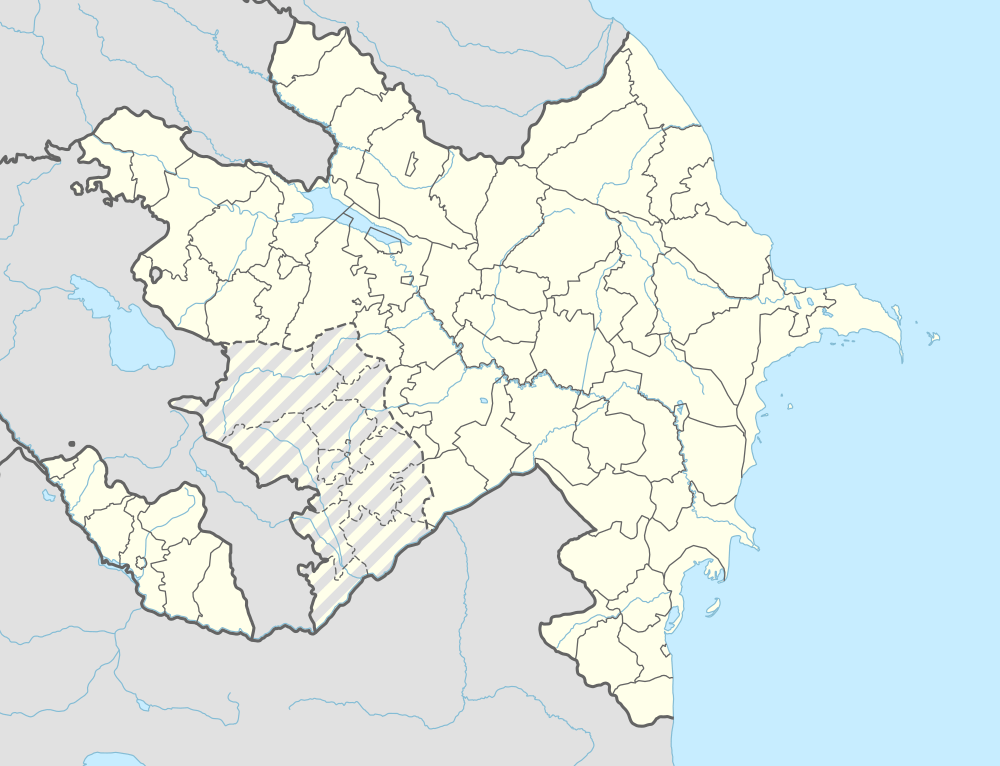 Ordubad | |
| Coordinates: 38°54′29″N 46°01′40″E / 38.90806°N 46.02778°ECoordinates: 38°54′29″N 46°01′40″E / 38.90806°N 46.02778°E | |
| Country |
|
| Autonomous republic | Nakhchivan Autonomous Republic |
| Rayon | Ordubad |
| Population | |
| • Total | 10,372 |
| Time zone | AZT[1] (UTC+4) |
| Postal code | AZ6900 |
| Area code(s) | +994 036 |
Ordubad (also, Ordoubat and Ordubat), is the second largest town and a municipality of the Nakhchivan Autonomous Republic of Azerbaijan and is one of its three regions. It is the capital of the Ordubad rayon. Ordubad declared a medieval city of the Caucasus in its current capacity of a town was founded in the 18th century. The town is divided into five districts of the Ambaras, the Kurdtatal, the Mingis, the Sar sheher, and the Uch. Ordubad is known as the “pearl” of Nakhchevan province and is well known for its exports of fruits and spices, and for its cuisine.
Etymology
Ordubad is a name of Turco-Persian origin and means "city of army" (from Turkic ordu (army) and Persian bad (city)), which implies that the city was founded during the period of the Mongol or the ensuing Il-Khanid rule.[2]
Location
The Ordubad city, known as the “pearl” of Nakhchevan province,[3] is located at an elevation of 949 metres (3,114 ft). It is in the northern bank of the central stretch of the Araxes (Aras) river of the eastern Transcaucasia which earlier belonged to Persia, now in Azerbaijan. the second largest town.[2][4] The Ordubad Province itself has an area of 972 square kilometres (375 sq mi) and is delimited by Iran on the south, Armenia forming the north and west border, and the Julfa region of Nakhchivan bordering the east.[5] The river that rises from the north from the Mt. Qobān (also known as Tk. Qapïjïq, Rus. Kapudzhukh or Kapydzhik) at an elevation of 3,904 metres (12,808 ft) drains into the Araxes.[2] The town is divided into five districts of the Ambaras, the Kurdtatal, the Mingis, the Sar sheher, and the Uch.[6] The city has a large number of walnut and mulberry trees.[7] The closest railway station is Ordubad and the distance to Nakhchivan city is 88 kilometres (55 mi). Tabriz is 94 kilometres (58 mi) away to the north-northwest.[2]
Demographics
In 1999 the population of the city was reported as 5,000. Most of the population belonged to the Shiite Muslim sect with Armenians and Russians forming a minority.[7]
History
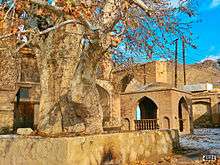
The Ottoman Empire (1299–1923) had occupied the Ordubad territory in the past. Before this occupation, a local rebellion had been organized against invasion of the Ottomans by Hadji, known as “Kasab” (butcher) and Bayandar when they came to know that Saffavids were to launch an attack. They were backed by the local people. The rebels initially took control of the city and also occupied a fortress near the city. However, the rebels had their own internal dissensions, and as a result a small battalion of the Ottoman army defeated the rebels and killed them. Following this victory and occupation by the Ottomans, Khaten bey Ordubadi, the prime vizier, appealed to the Shah to waive off all taxes levied on the local people, which was agreed.[8]
Ordubad was once an important regional stop on the caravan route of the Silk Road trade with China, Europe and India. The city was first founded as Gala city, a feudal city, on the top of the Ambras on the left bank of Ordubadchay River in the 15th century. In view of extensive trade, the city started developing on the right bank of the Ordubadchay with many new districts. In the 17th and 18th centuries trade centres were established in the city on the right bank, which diminished the importance of Gala city. Built in the backdrop of Zangezur Caucasus mountain it is enclosed on three sides by mountains providing for a very green environment. In the 17th century the city underwent major reconstruction activity, maintaining eastern feudal architectural features.[6] Following the Russo-Persian War (1826-1828), the town passed from Iranian rule to Imperial Russian rule under the Treaty of Turkmenchay of 1828. The province of Ordubad with its 52 villages had a population of 11,341 in 1834 mostly constituted of Muslim Azerbaijanis and small community of Russians and Armenians.[2]
The Ordubad site was added to the UNESCO World Heritage Tentative List on 24 October 2001 in the Cultural category under Criteria (i), (iv) and (v).[6]
Archaeological excavations
Archaeological excavations carried out by Russian archaeologists in ancient settlements of Ordubad have unearthed remnants of Bronze age dated to the fourth century.[9] It includes a necropolis, which revealed graves of warriors also dated to the fourth century. These were initially assessed, in 1928, as skeletons of only warrior men but subsequent research carried out by the Archaeological and Ethnological Institute of Azerbaijan National Academy of Science in 2004 has concluded that at least one of the skeletons is of a woman warrior found with her armory such as quiver, arrows and helmet.[9]
Economy
Ordubad economy is dependent on trading particularly of fruits, wheat, and silk; grapes are of 40 varieties. The silk exports have been mostly to Venice, Marseille, Amsterdam and many other places in Europe, from the middle of the 16th century. During the early years of 20th century the Ordubad silk received 13 gold medals in the international exhibitions and fairs.[5][3] Arak is also an export commodity of the city.[7] Economic activity in Ordubad and near by regions includes copper mining, Paragachayskoe molybdenum deposit from the Meghri-Ordubad gratoidnym batholiths, bauxite, tungsten and tin ore.[10]
Features of the city
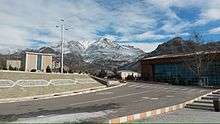
In the new city of Ordubad, planned in the 17th century, there were five divisions or districts with trade squares of larger size than the earlier blocks, which also had a plethora of mosques, springs, and bath-houses. The medieval market square in the heart of the city is prominent and the glass mosque, the Cümə Mosque, is a landmark. Caravan sheds and the market here traded in silk and dry fruits with East European countries. The lay out of the streets is radial and appears in the shape of a fan close to the center of the city. Each of the streets have squares which are a typical feature of the city.[6] A well known suburb of the city is Akulis through which a small stream flows. The city has many private and public schools.[7] The city has a number qanats or underground canals called "kahriz", which are the source of water for houses and orchards.[11] The city reflects tradition and culture of northern and southern Azerbaijan.[3]
Cümə Mosque
Cümə Mosque, in the heart of the city, was initially built as the office of Hatambek Ordubadi vizier of Shah Abbas, in the 17th-century. Even now it looks more like a palace. The history museum, located on the opposite side, is a domed structure that is dated to 18th century which in the past was used as a silk shop, restaurant and zurkhaneh ("house of strength"). Soviet era photos are exhibited here. The porch here was once decorated with statues of Russian communists and the roof was also designed in Russian architecture, and these have since been removed. [12]
Qeyyseriye
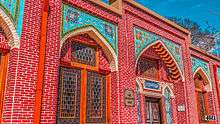
Qeyyseriye building is a historic edifice dated to the 17th century, located in the main market centre. It is now a historical and ethnography museum.[5]
Gemigaya Mountain
Gemigaya Mountain is an important backdrop to the city which is known for its petroglyphs, necropolises, and ancient settlements of Ordubad, Sabirkend, Plovdagh and Kharaba Gilan, which attests to its occupancy between 7th to 1st century BC.[5] It is situated within the Ordubad National Park.[11]
Observatory
In the Astronomical Observatory at Ordubad, Nakhichevan ASSR and also at the Tarija, Bolivia, with the help of expedition astrograph, 6,000 plates were recorded from 1983–1988 which cataloged 200,000 stars south of the equator up to the 11th magnitude.[13]
Notable natives
- Hatim Beg Urdubadi - Safavid vizier from 1591 to 1610/1.
- Mirza Talib Khan Urdubadi - Safavid vizier from 1632 to 1633.
- İsmayıl İbrahimov — Scientist, Hero of Socialist Labor.[14]
- Mammed Said Ordubadi — Writer.[15]
- Najafgulu Rafiyev — Hero of the Soviet Union.[16]
- Novruz Rizayev — People's Commissar of Internal Affairs of Azerbaijan SSR (1927–1929).[17]
- Victor Cherokov — Soviet military commander, Vice Admiral.[18]
- Yusif Mammadaliyev — chemist, founder of petrochemical science in Azerbaijan.[19]
References
- ↑ Azerbaijan cancels daylight saving time
- 1 2 3 4 5 "Ordubād". Encyclopaedia Iranica. Retrieved 21 November 2015.
- 1 2 3 Rustamkhanli 2013, p. 175.
- ↑ USSR: Administrative Territorial Division of the Union Republics, Moscow, 1977
- 1 2 3 4 "Ordubad: an ancient city in the heart of Eurasia". Foreign Policy News. 17 October 2014. Retrieved 19 November 2015.
- 1 2 3 4 "Ordubad historical and architectural reserve". UNESCO Organization. Retrieved 19 November 2015.
- 1 2 3 4 Sayyāḥ 1999, p. 281.
- ↑ Zardabli 2014, p. 318.
- 1 2 Mayor 2014, p. 73.
- ↑ Publications 2007, p. 73.
- 1 2 "Introducing Ordubad". Lonely Planet. Retrieved 21 November 2015.
- ↑ Noble, Kohn & Systermans 2008, p. 293-94.
- ↑ McNally 2012, p. 232.
- ↑ Ибрагимов Исмаил Али оглы (in Russian). Heroes of the country.
- ↑ "Ордубады Мамед Саид". Great Soviet Encyclopedia.
- ↑ "Рафиев Наджафкули Раджабали оглы". Heroes of the country.
- ↑ "Rizayev Novruz Kerim oglu". Minister of National Security Azerbaijan Republic.
- ↑ "Чероков Виктор Сергеевич". Great Soviet Encyclopedia.
- ↑ "член-корреспондент Юсиф Гейдарович Мамедалиев". Faculty of Chemistry, Moscow State University.
Bibliography
- McNally, Derek (2012). Reports on Astronomy. Springer Science & Business Media. ISBN 978-94-011-3364-7.
- Mayor, Adrienne (2014). The Amazons: Lives and Legends of Warrior Women across the Ancient World. Princeton University Press. ISBN 978-1-4008-6513-0.
- Noble, John; Kohn, Michael; Systermans, Danielle (2008). Georgia, Armenia & Azerbaijan. Ediz. Inglese. Lonely Planet. ISBN 978-1-74104-477-5.
- Publications, USA International Business (2007). Azerbaijan Mineral & Mining Sector Investment and Business Guide. Int'l Business Publications. ISBN 978-1-4330-0349-3.
- Rustamkhanli, Sabir (2013). My Road of Life. AuthorHouse. ISBN 978-1-4817-9182-3.
- Sayyāḥ, Muḥammad ʻAlī (1999). An Iranian in Nineteenth Century Europe: The Travel Diaries of Haj Sayyah, 1859–1877. Ibex Publishers, Inc. ISBN 978-0-936347-93-6.
- Zardabli, Ismail bey (2014). The History of Azerbaijan: from ancient times to the present day. Lulu.com. ISBN 978-1-291-97131-6.
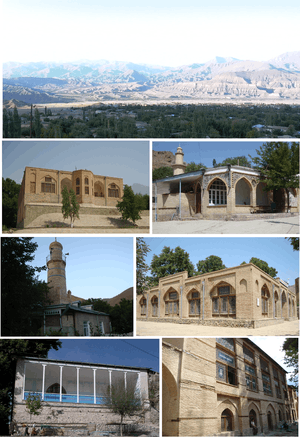
.svg.png)